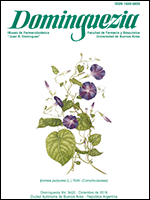Ver ítem
- xmlui.general.dspace_homeCentros e Institutos de InvestigaciónCIRN. Centro de Investigaciones de Recursos NaturalesInstituto de Recursos BiológicosArtículos científicosxmlui.ArtifactBrowser.ItemViewer.trail
- Inicio
- Centros e Institutos de Investigación
- CIRN. Centro de Investigaciones de Recursos Naturales
- Instituto de Recursos Biológicos
- Artículos científicos
- Ver ítem
Estudio farmacobotánico de Ipomoea purpurea (L.) Roth (Convolvulaceae)
Resumen
Ipomoea purpurea (L.) Roth (Convolvulaceae) es una especie que se desarrolla en las zonas tropicales de ambos hemisferios. Por el atractivo de sus flores pertenece al grupo conocido como “Common morning glory”, especies empleadas por diversos grupos nativos en rituales mágico - religiosos y popularmente como alucinógeno, analgésico, antiinflamatorio y purgante, entre otros. Dada la gran similitud de I. purpurea con otras especies del mismo género
[ver mas...]
Ipomoea purpurea (L.) Roth (Convolvulaceae) es una especie que se desarrolla en las zonas tropicales de ambos hemisferios. Por el atractivo de sus flores pertenece al grupo conocido como “Common morning glory”, especies empleadas por diversos grupos nativos en rituales mágico - religiosos y popularmente como alucinógeno, analgésico, antiinflamatorio y purgante, entre otros. Dada la gran similitud de I. purpurea con otras especies del mismo género (características ecológica, morfológicas y fitoquímicas), se plantean actualmente discusiones de identificación incluso a nivel taxonómico. El objetivo de este estudio es determinar las principales características diagnósticas para la identificación de I. purpurea y registrar sus atributos morfoanatómicos generales. Se trabajó con material fresco proveniente de INTA Castelar y ejemplares de herbario. Se analizaron las hojas, tallos, raíces, flores y semillas. Se realizaron disociados leves, fuertes, raspados, reducción a polvo, cortes transversales, improntas de epidermis y peeling. Se realizaron reacciones histoquímicas para almidón, lípidos y antocianos. El material se observó mediante microscopía de luz clara, contraste de fase (DIC) y luz polarizada y se realizó microscopía cuantitativa. Entre los caracteres principales pueden mencionarse: en las hojas, epidermis con estomas paracíticos y anomocíticos, tricomas tectores unicelulares de tres tamaños diferentes, tricomas glandulares pluricelulares, drusas. En los tallos se observaron los mismos tricomas que en las hojas y tubos laticíferos. En la raíz, laticíferos, almidón y drusas. En la flor, tricomas tectores similares a los de las hojas pero con base ensanchada y tricomas glandulares, drusas, antocianinas y granos de polen equinados-pantoporados. En las semillas, esclereidas, lípidos, granos de almidón de diferente tamaño y de formas esférica y ovoidal, ambos con hendidura presente, drusas y cavidades, aparentemente, de tipo esquizógeno. Los tres tamaños diferentes de tricomas tectores, los tricomas glandulares y las cavidades presentes en la semilla constituyen la primera observación para esta especie. Este estudio proporciona datos relevantes para I. purpurea y provee elementos de diagnóstico para ser empleados en la diferenciación respecto de otras especies taxonómicamente afines.
[Cerrar]
Ipomoea purpurea (L.) Roth (Convolvulaceae) is a species that develops in the tropical regions of both hemispheres. Is belong to the group known as “Common morning glory” on account of the beauty of its flowers, species used by various native groups in magic - religious rituals and popularly as hallucinogenic, analgesic, anti - inflammatory and laxative, among others.The great similarity of I. purpurea with other species of the same genus (such as
[ver mas...]
Ipomoea purpurea (L.) Roth (Convolvulaceae) is a species that develops in the tropical regions of both hemispheres. Is belong to the group known as “Common morning glory” on account of the beauty of its flowers, species used by various native groups in magic - religious rituals and popularly as hallucinogenic, analgesic, anti - inflammatory and laxative, among others.The great similarity of I. purpurea with other species of the same genus (such as ecological, morphological and phytochemical characteristics), leads to discussions of identification, even at a taxonomic level. The aim of this study was to determine the main diagnostic characteristics for the identification of I. purpurea and to record its general morphoanatomical attributes. We work with fresh INTA Castelar material and herbarium samples. The leaves, stems, roots, flowers and seeds were analyzed by soft, strong, scraped dissociations, reduction to dust, cross sections, traces of the epidermis and desquamation. Histochemical reactions were performed for starch, lipids and anthocyanins. Qualitative and quantitative microscopy was performed on fresh and dry material by bright-field microscopy, phase contrast (DIC) and polarized light. Among the main characters may be mentioned: in the leaves, epidermis with paracytic and anomocitic stomata, unicellular tissue trichomes of three different sizes, pluricellular glandular trichomes, clusters of calcium oxalate. In the stems were observed laticiferous tubes and the same trichomes as in the leaves. In the root, laticiferous, starch and clusters of calcium oxalate. In the flower, trichomes tectores similar to those of the leaves but with widened base and glandular trichomes, clusters of calcium oxalate, anthocyanins and equine-pantoporated pollen grains. In the seeds, sclereids, lipids, starch grains of different size and spherical and ovoidal shapes, both with a cleft present, clusters of calcium oxalate and cavities, apparently of the schizogenic type. The three different sizes of trichomes, the glandular trichomes and the cavities present in the seed constitute the first observation for this species. This study provides relevant data for I. purpurea and provides diagnostic elements to be used in the differentiation with respect to other species taxonomically related.
[Cerrar]

Autor
Monsalvo, Maria Alexandra;
Fortunato, Renee Hersilia;
Wagner, Marcelo;
Ricco, Rafael A.;
Fuente
Dominguezia 34 (2) : 21-29 (2018)
Fecha
2018-01-04
Editorial
Facultad de Farmacia y Bioquímica,
Universidad de Buenos Aires
ISSN
1669-6859
Formato
pdf
Tipo de documento
artículo
Palabras Claves
Derechos de acceso
Abierto
 Excepto donde se diga explicitamente, este item se publica bajo la siguiente descripción: Creative Commons Attribution-NonCommercial-ShareAlike 2.5 Unported (CC BY-NC-SA 2.5)
Excepto donde se diga explicitamente, este item se publica bajo la siguiente descripción: Creative Commons Attribution-NonCommercial-ShareAlike 2.5 Unported (CC BY-NC-SA 2.5)


